Showcase
Here we list some of the past projects done in the AY20/21 Semester 1 iteration of CS3244 – this page exists to archive some of the highlights from past projects, and also to serve as inspiration for future projects.
The projects here span a variety of different fields, from investigating classical ML techniques, NLP, vision, audio and even advanced concepts such as Reinforcement Learning and Generative Adverserial Networks(GANs).
Projects | Posters |
|---|---|
Team 08: Slime VB🗂️ Project TypeReinforcement Learning 📖 Abstract In Slime Volleyball, a two-player competitive game, we investigate how modelling uncertainty improves AI players’ learning in 3 ways: against an expert, against each other and against itself, in the domain of multi-agent reinforcement learning (MARL). We show that by modelling uncertainty, Bayesian methods improve MARL training in 4 ways: performance, training stability, uncertainty and generalisability, at the relatively small trade-off of sample efficiency, and through experiments using TensorFlow Probability and Stable Baselines, we present interesting differences in agent behaviour. We contribute 3 code functionalities: Bayesian methods using Flipout integrated into Stable Baselines, multi-agent versioned learning framework for Stable Baselines (previously with only single-agent support) and uncertainty visualisation using agent clones for Slime Volleyball Gym. ☀️ Team Members
📻 Media Links[ Poster ] [ Website ] | 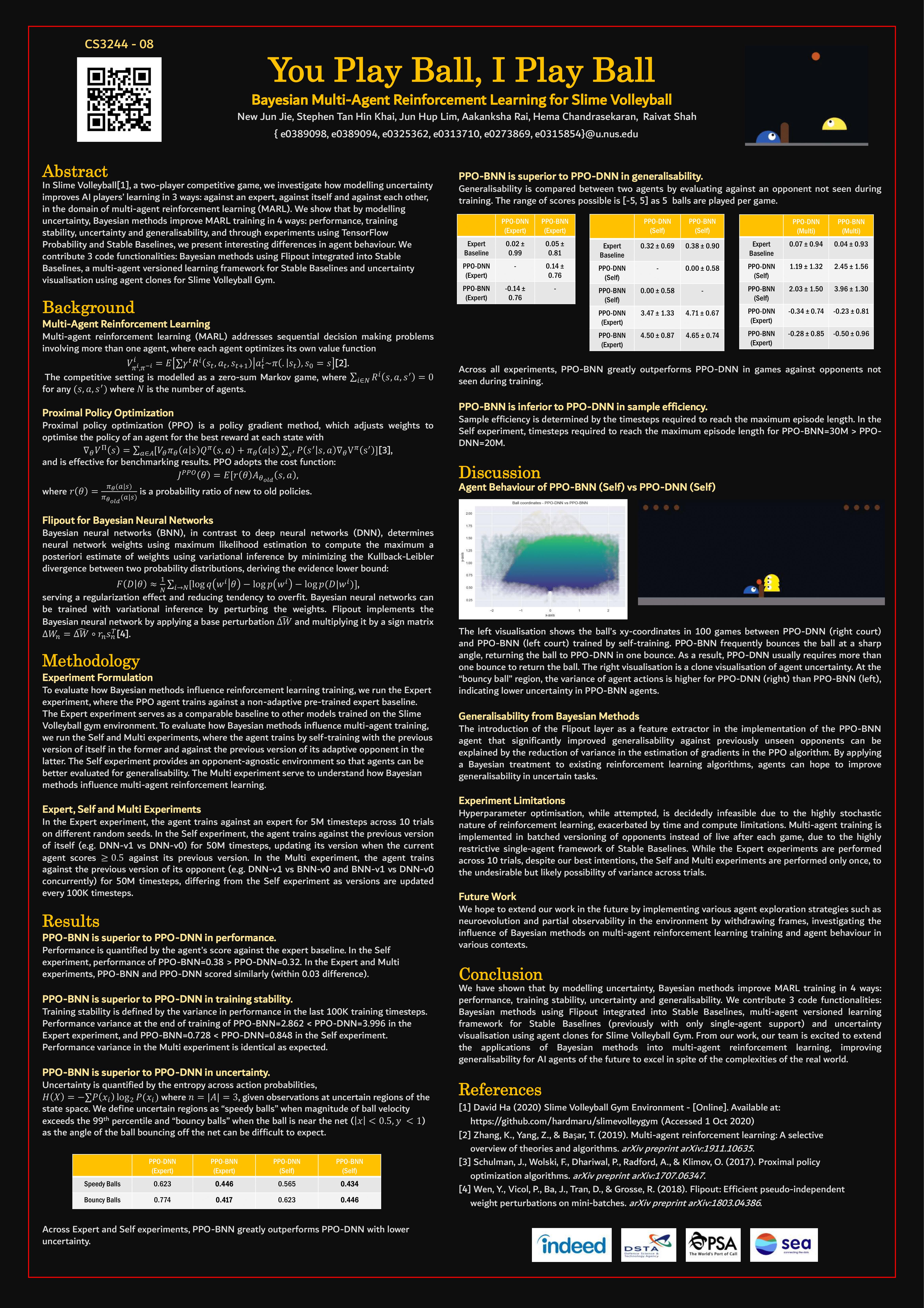 Click the image to enlarge |
Team 21: Finding Drug Treatments Faster Though Machine Learning🗂️ Project TypeMulti Label Classification 📖 Abstract This project tackles the kaggle competition called “Mechanism of Action” (MoA) which presents a multi-label classification problem. The objective is to label the Mechanism(s) of Action of different drugs, given how human cells have reacted to them. Our project’s main goal is to implement a model that can consistently achieve high target scores on kaggle, after fine tuning the model and performing exploratory data analysis. We investigated techniques that use ensembling methods as well as neural networks. ☀️ Team Members
📻 Media Links[ Poster ] [ Video ] | 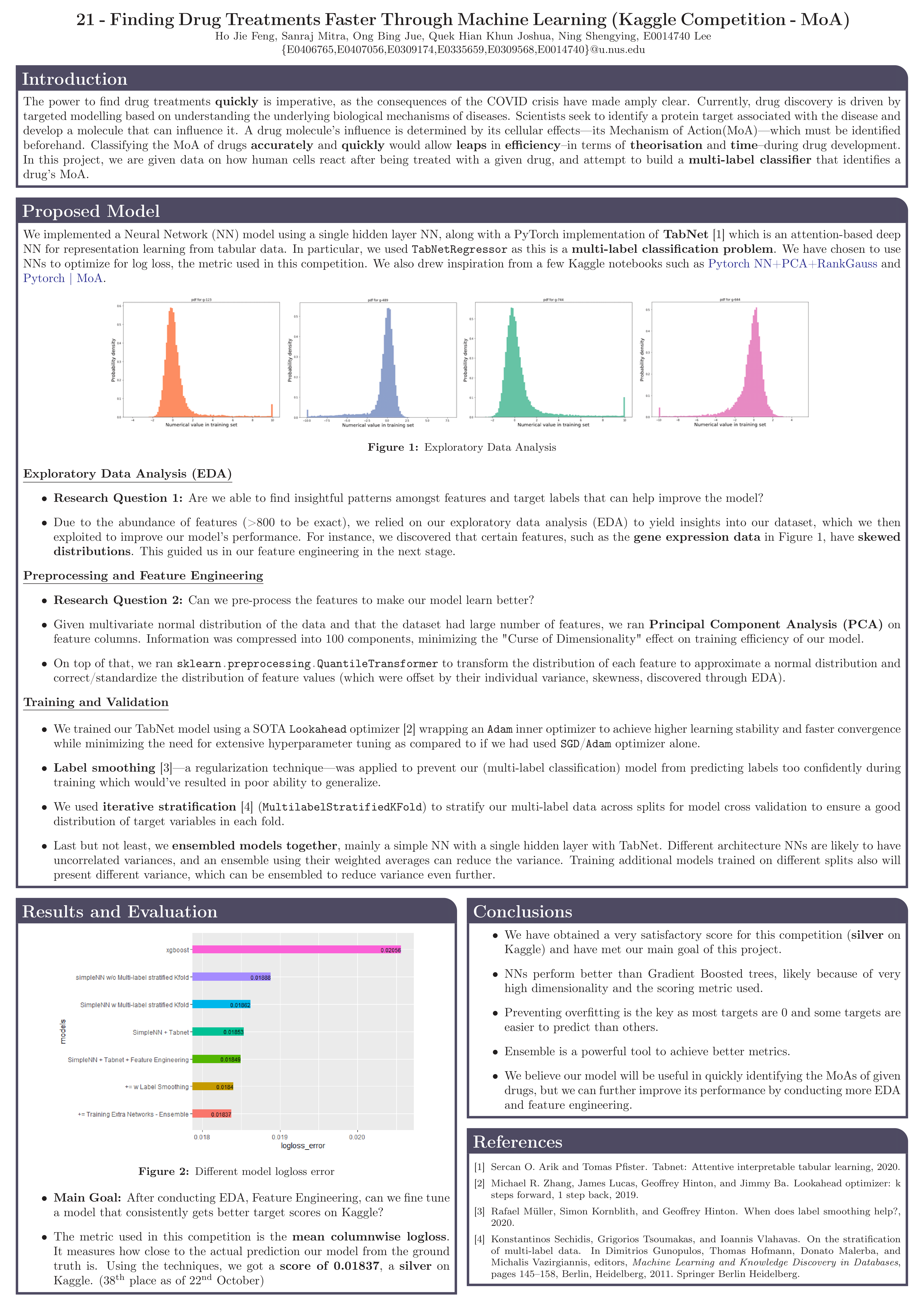 Click the image to enlarge |
Team 42: Poem Grade🗂️ Project TypeNatural Language Processing & Classification 📖 Abstract This project investigates the viability of an automatic approach to classifying poems by the grade or age of a student author. A public corpus of poems written by children from grades 2 to 8 is used as the dataset. Our study is motivated by potential practical applications in assisting educators in benchmarking students writing and its theoretical significance in fields such as language development and education. It differs from existing work in that we attempt to classify specific grades, and classification of children’s poetry has not been previously attempted. Multiple traditional classification approaches to text classification with various methods of encoding the poems were compared against more complex neural network approaches. Neural network models achieved better performance than traditional models, but only moderate levels of predictive accuracy could be achieved due to a high degree of overlap between the grades. ☀️ Team Members
📻 Media Links[ Poster ] [ Video ] | 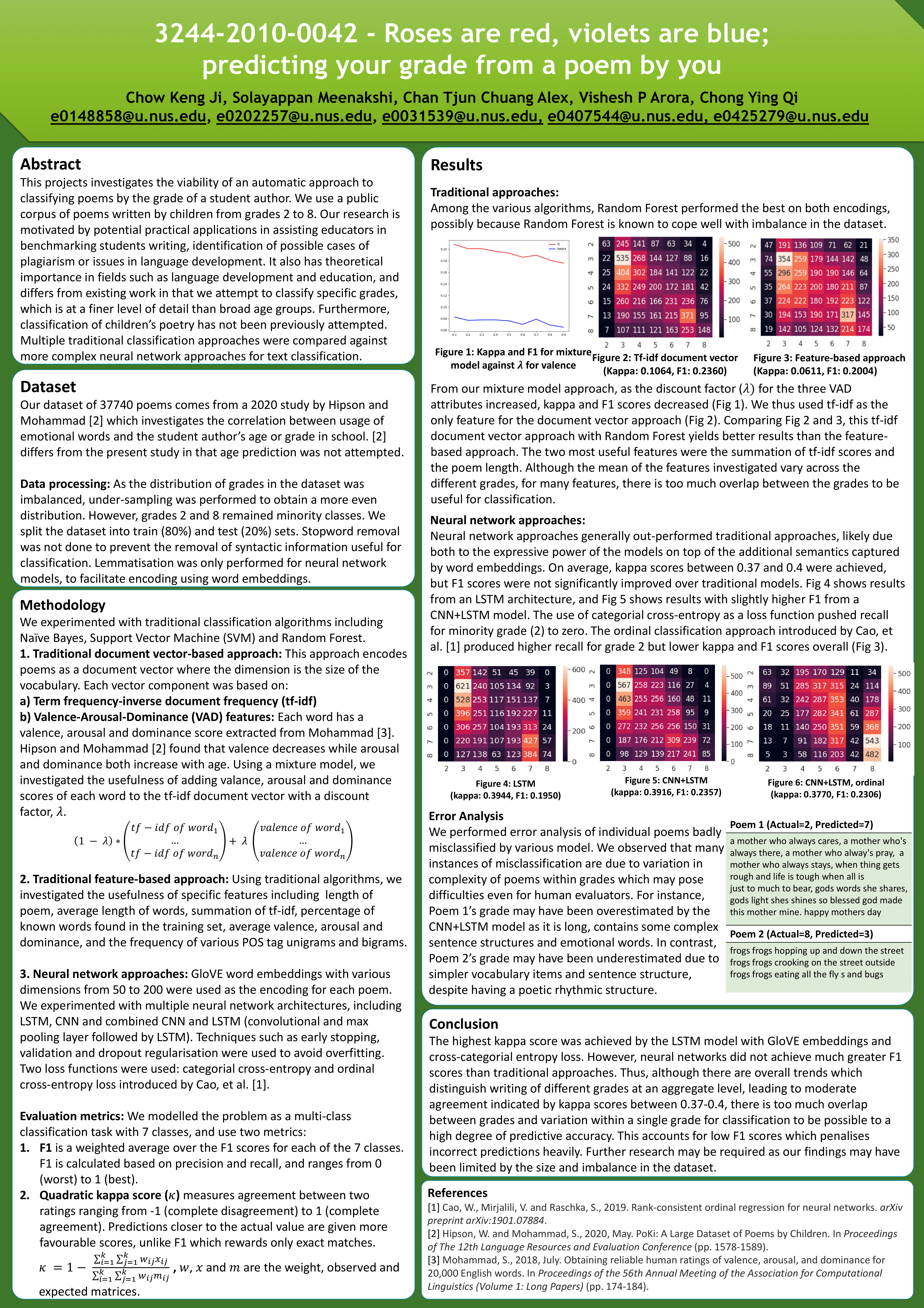 Click the image to enlarge |
Team 17: Detecting COVID-19 in Radiographic Images Using Deep Learning🗂️ Project TypeComputer Vision & Binary Classification 📖 Abstract The main goal of this project was to determine if an individual was infected with the 2019 Novel Coronavirus (COVID-19) by analyzing their chest X-rays (CXRs) with machine learning techniques. We sought first to determine whether or not it was possible to detect COVID-19 by analyzing CXR and, if it was possible, to explore how deep learning can improve upon traditional machine learning techniques in diagnosing COVID-19. These included investigating how deep learning could be used to extract features indicative of COVID-19 from CXRs, and if transfer learning could be utilized to retrain existing image classification networks for our purposes. In our results, the best performing model (transfer learning with DenseNet-121) achieved a high COVID-19 sensitivity score of 98.62%, and a weighted sensitivity score of 96.21%. This is comparable to the results of similar work done for pneumonia detection, and is better in performance than common COVID-19 detection tests like antigen tests. ☀️ Team Members
📻 Media Links[ Poster ] [ Video ] | 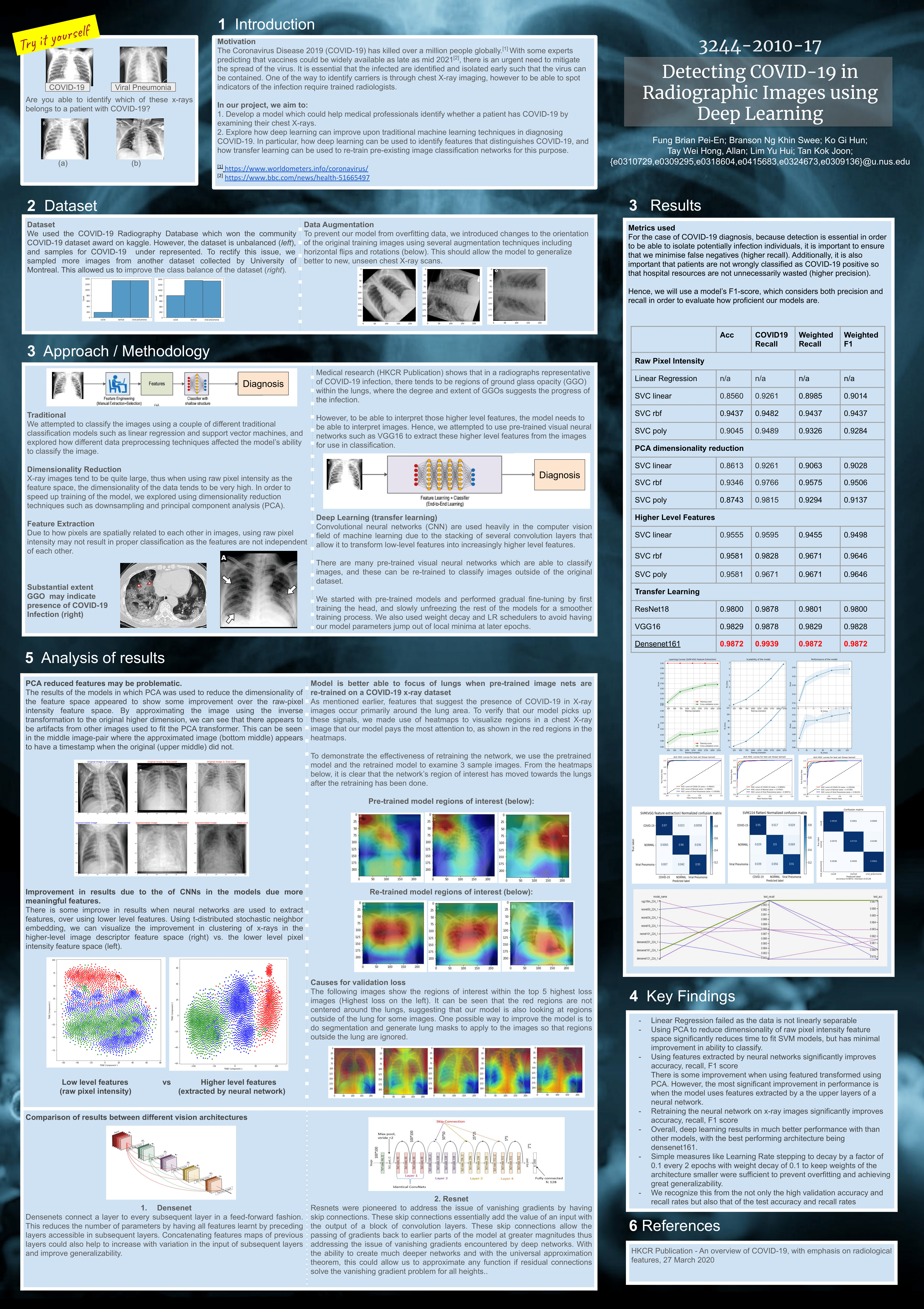 Click the image to enlarge |
Team 06: Evolving Handwritten Words, One At A Time🗂️ Project TypeComputer Vision 📖 Abstract Using Deep Learning to predict handwritten texts, we can help to increase the efficiency of workers who often struggle to read illegible handwritten documents. We aim to build a model that can predict English handwritten texts word-by-word; this model can then be used by workers to aid in their daily operations. Using Convolutional Neural Networks coupled with Bidirectional Long-Short Term Memory neural networks, we are able to achieve a prediction accuracy of 78% on handwritten words, which is further boosted to 81% after passing our results through an existing vocabulary spell checker. ☀️ Team Members
📻 Media Links[ Poster ] [ Video ] | 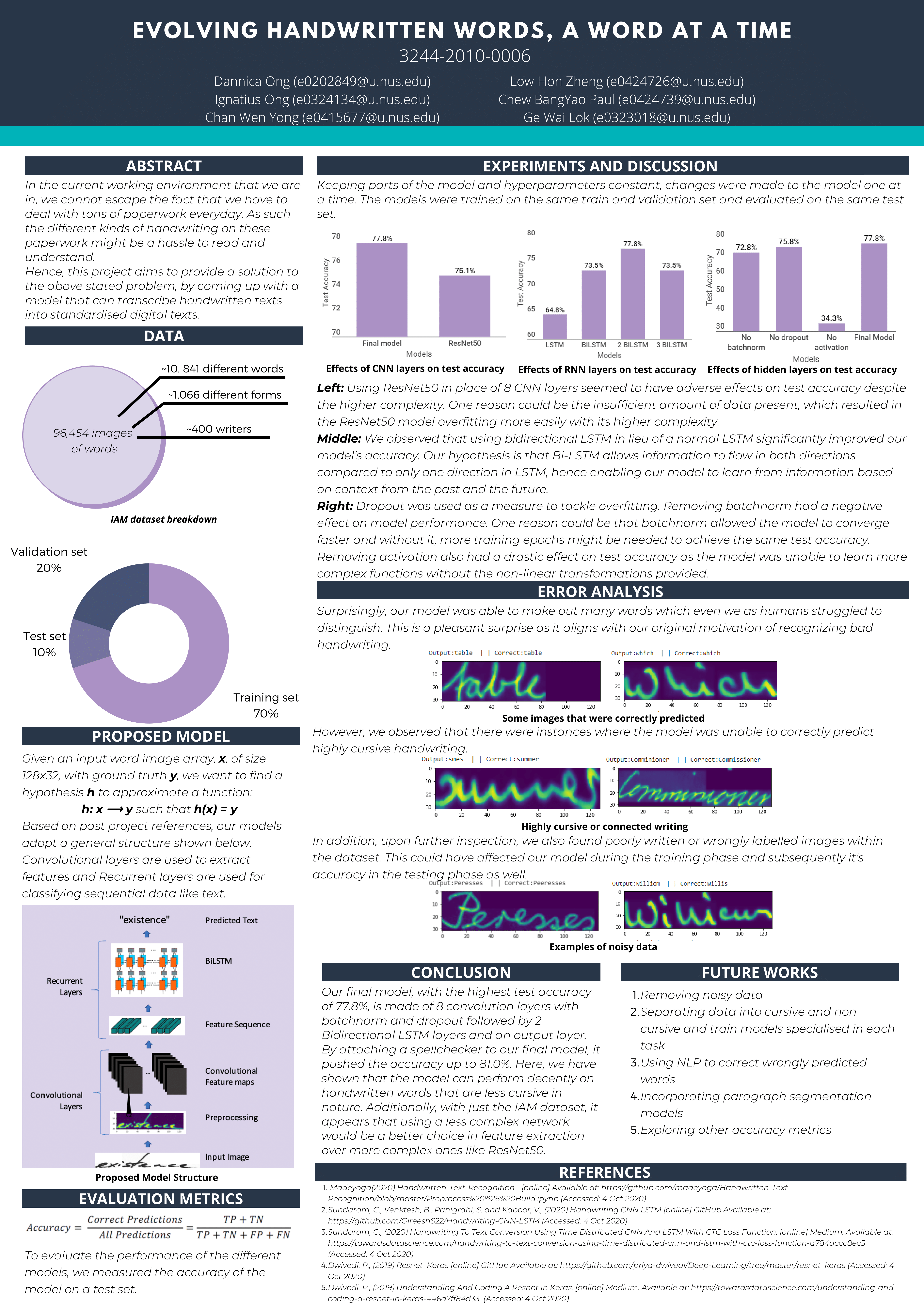 Click the image to enlarge |
Team 01: Color-Coded🗂️ Project TypeComputer Vision and Generative Adversarial Networks 📖 AbstractColour-Coded is a project exploring colourisation of grayscale images via machine learning (ML) on the 102 Flowers Dataset. Colourization is typically a manual and tedious process. With the use of Convolutional Neural Networks (CNNs), we can train a model to learn and perform this task automatically, with plausible results. This sees wide applications ranging from colour recovery of historical film footage to improving CCTV recordings and scientific research results. ☀️ Team Members
📻 Media Links[ Poster ] [ Video ] | 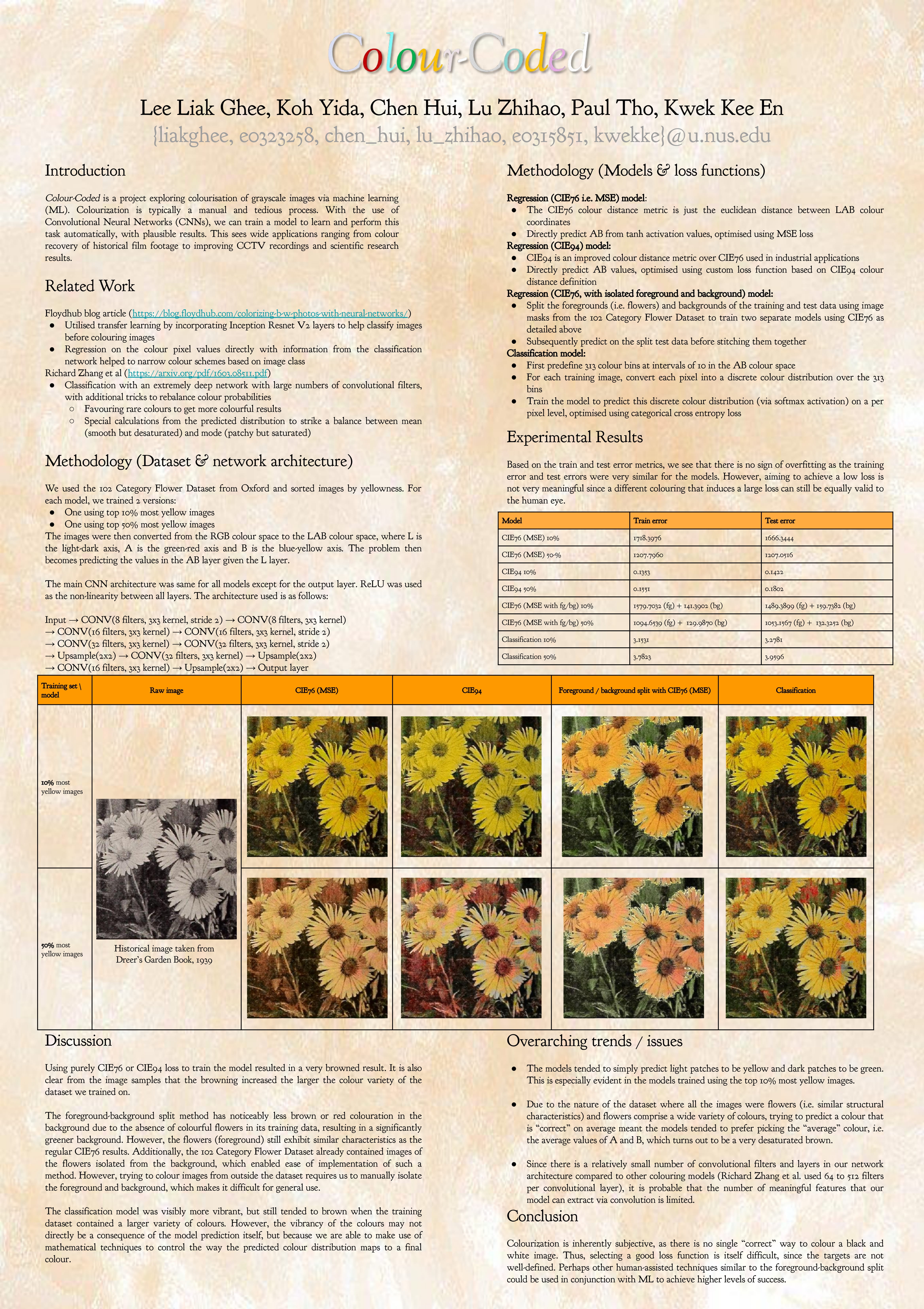 Click the image to enlarge |
Team 05: Future Stock Prices🗂️ Project TypeTime Series Forecasting 📖 Abstract The project explores the extent to which future stock prices can be predicted using supervised machine learning models with fundamental and technical analysis data as inputs. ☀️ Team Members
📻 Media Links[ Poster ] [ Video ] | 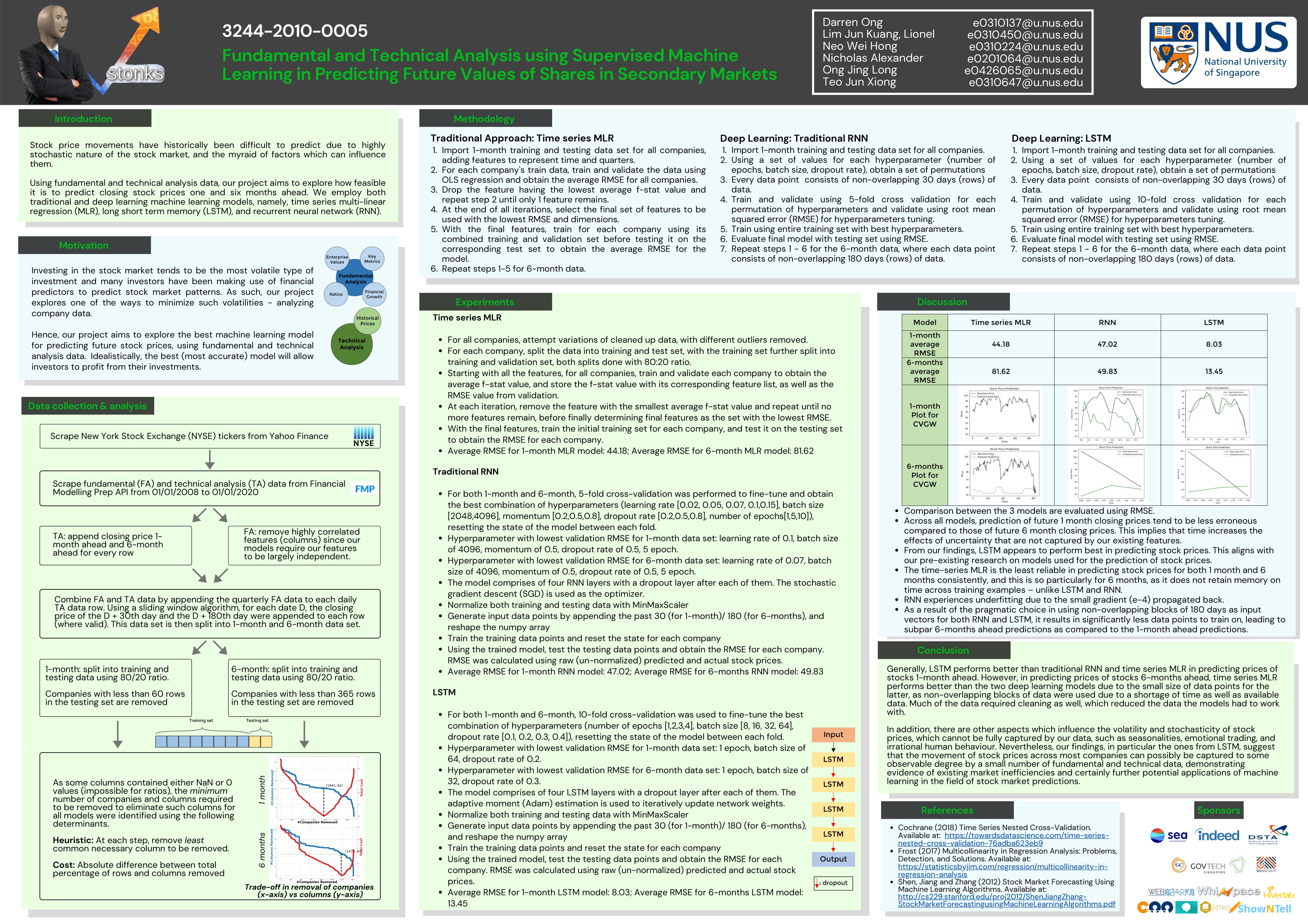 Click the image to enlarge |
Team 38: Playlister🗂️ Project TypeAudio 📖 AbstractRecommendation systems are a key component of the media industry as they provide users with the ability to filter enjoyable content for their perusal. These systems mainly use the following two methods to generate recommendations: collaborative methods and content-based methods. In this project, we designed Playlister, a music playlist recommendation system that recommends songs using content-based methods. Using a combination of machine learning techniques such as signal processing, genre classification, sentiment analysis and unsupervised learning, Playlister is able to generate playlists of different lengths according to the user’s preferences. ☀️ Team Members
📻 Media Links[ Poster ] [ Video ] |  Click the image to enlarge |
Team 2: Big Hit🗂️ Project TypeTabular Prediction 📖 AbstractThis project aims to solve the Hit Song Science problem, which is, to predict which songs have the potential to become a Billboard Top 100 hit. Using a dataset of songs alongside song metadata (energy score, danceability score etc.) and lyrics, our project aims to find the best model for predicting song popularity and discover any relationship between song features and song popularity. We will be building 3 models, Support Vector Machine, Logistic Regression and Neural Network, and compare them using cross-validation accuracy, accuracy, F1 score and AUC ROC, to determine which model works the best for this problem. ☀️ Team Members
📻 Media Links[ Poster ] [ Video ] | 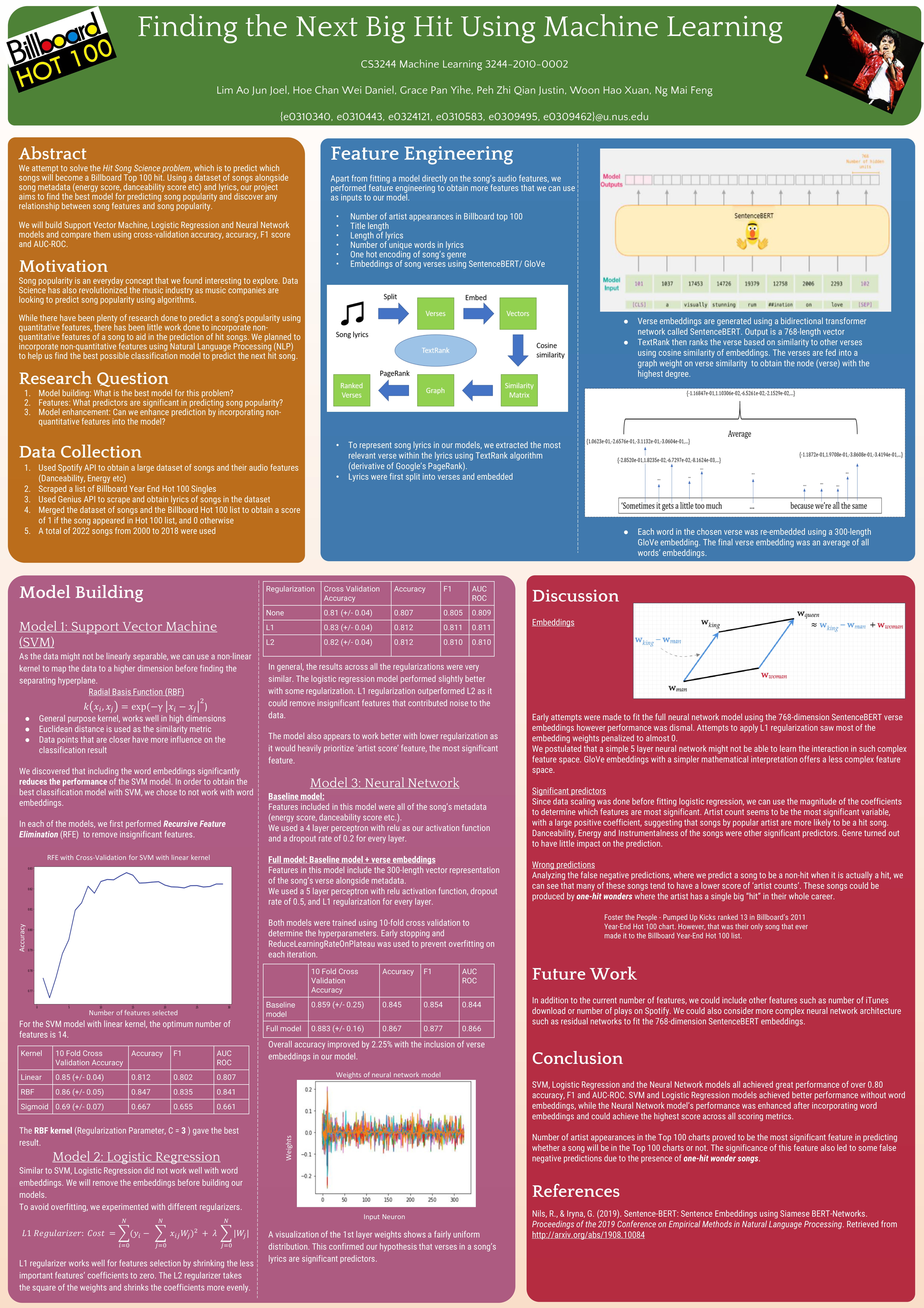 Click the image to enlarge |
Team 26: Football🗂️ Project TypeTabular Prediction 📖 AbstractIt is common practice for team managers to utilise the numerous match features such as player ratings, historical wins-losses and team formations, etc., to predict a team’s performance in a matchup. By using data from major European football leagues, our research aims to provide an in-depth analysis of ML applications in football predictive modelling . Building on numerous past studies exploring this field, we will utilise multiple supervised ML models such as Naïve-Bayes (NB), k-Nearest Neighbours (kNN) and Support Vector Machine (SVM), to gain a better insight on the importance of different features in predicting the outcome of these matches. Additionally, we aim to identify the flaws in these models and explore measures to mitigate them. ☀️ Team Members
📻 Media Links[ Poster ] [ Video ] | 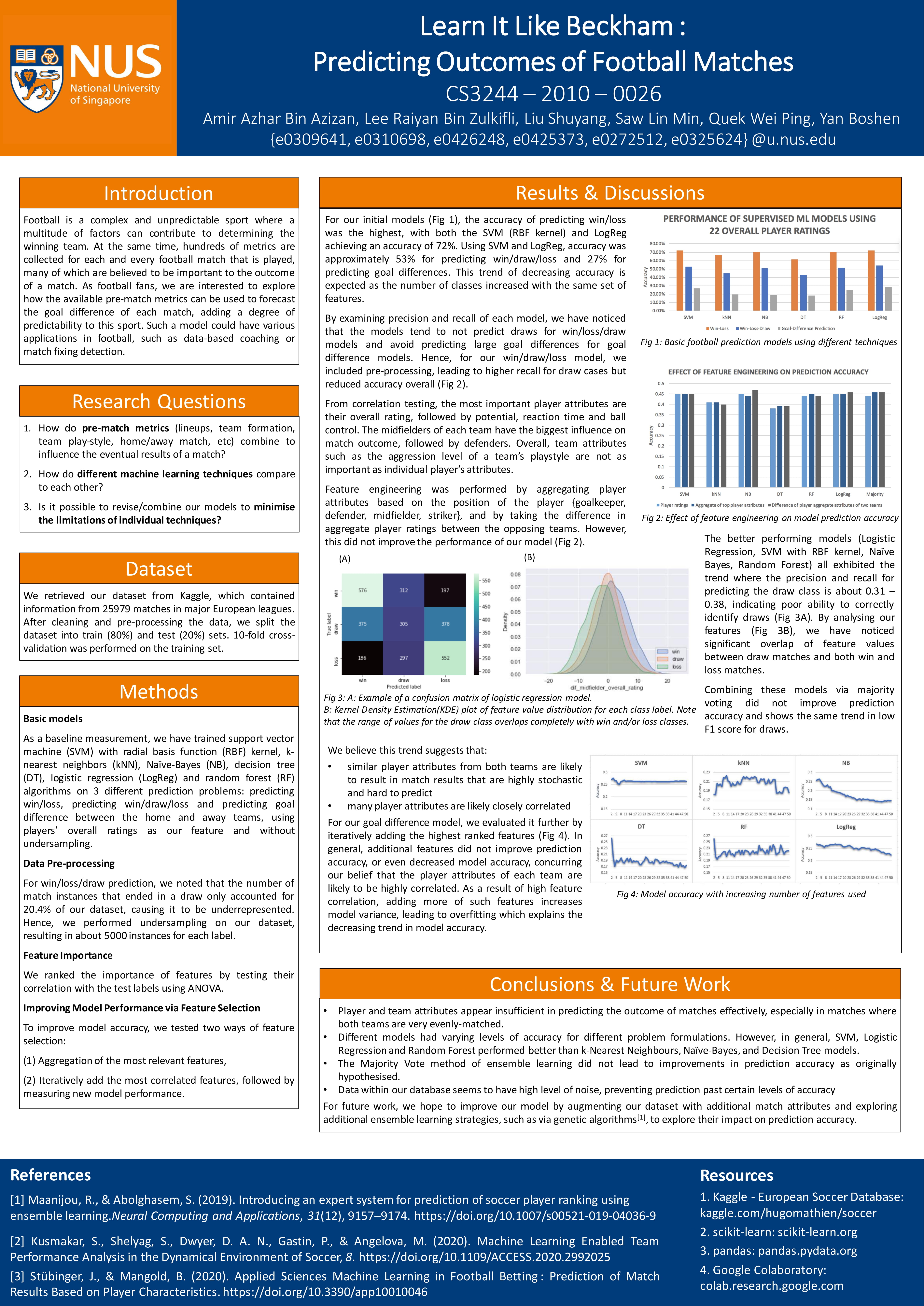 Click the image to enlarge |